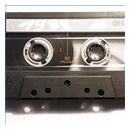Gracias kamikaze. Ya lo habia probado, pero no ha surgido ningun efecto...
Es extraño, porque todas las funciones y parametros del menu funcionan bien y el reloj responde a los cambios que realizo externamente... Pero no se encienden los leds de entrada. ¿Se habrá podido fundir el chip DA?

El manual dice en su pagina 6:
When modifying calibration levels, the Sample Rate display depicts the “wheels of gain”, which rotate clockwise to indicate increasing level and counterclockwise to indicate decreasing level, something like a volume knob.
Channel CAL mode is enabled by scrolling through the 7 front panel parameters until the CAL LED flashes, then pressing and holding either the PREV or NEXT buttons until “ch 1” scrolls across the Sample Rate display. Keeping in mind that Setup mode is always enabled while in Channel CAL mode, channel 1’s analog output may be modified by the same operations described on the previous page. To adjust channels 2-16, press either the PREV or NEXT button until the LED corresponding to the channel to be modified is lit.
Additionally, there are two extra parameters in the Channel CAL cycle: Oscillator On-Off and Oscillator Level. To engage the oscillator, press PREV or NEXT (while in Channel CAL mode) until “OSC – OFF” scrolls across the Sample Rate display, then press the UP button to turn the oscillator on (if the oscillator is on, press DOWN to turn it off). To set the Oscillator level, press PREV or NEXT, until “OSC – 16dBFs” scrolls across the Sample Rate display, and press UP or DOWN to set the oscillator to a value between -20 dBFs and 0 dbFs.
To exit Channel CAL mode, press and hold either PREV or NEXT again. Keep in mind that values entered while in either Global or Channel calibration mode won’t be saved in non-volatile memory until Channel CAL mode is exited and the Setup mode LED goes out.
Individual channel level changes made in Channel Cal mode are preserved when modifying all channel levels in Global Cal mode.
To calibrate the DA-16X, engage the internal oscillator at the desired digital reference level (between -20 and -12 dBFs) and calibrate the analog outputs until the desired analog reference level (most often +4 dBu) is attained. This may be most easily accomplished by measuring the AC voltage between the plus and minus legs of each analog output, and adjusting the calibration level until a voltage of 1.23 volts AC is attained. Any modern digital voltmeter will provide a sufficiently accurate measurement.
8 ) OPTICAL format – The format of the Optical inputs may be set to ADAT, S/MUX2 or S/MUX4 to accommodate the Optical format of connected devices. If the CLOCK SOURCE is either INTernal or WC, the OPTICAL format is determined by the Clock Source’s sample rate, and cannot be modified. If the CLOCK SOURCE is INPUT and INPUT is set to ADAT, the OPTICAL format is specified by the user.
9) AES format - The format of the AES inputs may be set to SINGLE or DOUBLE wire, to accommodate the AES format of connected devices. If the CLOCK SOURCE is either INTernal or WC and the sample rate is 44.1- 48kHz, only the SINGLE value is available; in all other cases both values may be selected.
10) INPUT – The DA-16X’s digital input may be sourced from either the ADAT, AES or OPTION card inputs. The OPTION value is not accessible when no card is installed. To use Optical input as a clock or input source, the ADAT 1-8 input must be connected first in precedence. When the DA-16X is set to Advanced Option routing configuration, the OPTION LED remains lit and INPUT may be toggled between ADAT and AES only. Please see page 8 for details.
11) Level Meters – Much more than mere signal presence indicators, these LEDs display digital Input level from –36 to 0 dBFs according to their brightness.
Probaste algo de esto?
Y antes que nada... Probaste y revisaste cables y conexiones?

Revisé cables y conexiones...
Sobre lo que comentas del manual tambien lo he probado. Lo único que consigo hacer es encender el oscilador y subirle o bajarle el volumen... Eso si me llega bien al convertidor de entrada... Pero referente a todo lo demás, calibración de canales y eso, es como si no hiciera nada...
Gracias de nuevo







